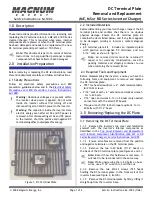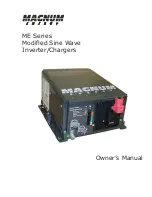
Nominal battery voltage
Charged voltage setting
12V
13.2V
24V
26.4V
36V
39.6V
48V
52.8V
7.2.3. Discharge floor
The “Discharge floor” parameter is used in the "time remaining" calculation. The battery monitor calculates the time it takes until
the set “
” has been reached. It is also used to set the state of charge alarm defaults.
For lead-acid batteries set this to 50% and for lithium set it lower.
Setting
Default setting
Range
Step size
Discharge floor
50%
0 - 99%
1%
7.2.4. Tail current
The battery is considered as fully charged once the charge current has dropped to less than this “Tail current” parameter. The
“Tail current” parameter is expressed as a percentage of the battery capacity.
Note that some battery chargers stop charging when the current drops below a set threshold. In these cases, the tail current must
be set higher than this threshold.
As soon as the battery monitor detects that the voltage of the battery has reached the set “
” parameter and
the current has dropped below this “Tail current” parameter for a certain amount of time, the battery monitor will set the state of
charge to 100%.
Setting
Default
Range
Step size
Tail current
4.00%
0.50 - 10.00%
0.1%
7.2.5. Charged detection time
” parameter must be met in order to consider the
battery fully charged.
Setting
Default setting
Range
Step size
Charged detection time
3 minutes
0 - 100 minutes
1 minute
7.2.6. Peukert exponent
Set the Peukert exponent parameter according to the battery specification sheet. If the Peukert exponent is unknown, set it at
1.25 for lead-acid batteries and set it at 1.05 for lithium batteries. A value of 1.00 disables the Peukert compensation. The Peukert
value for lead-acid batteries can be calculated. For more information on the Peukert calculation, the Peukert exponent and how
this relates to the battery capacity, see the
Battery capacity and Peukert exponent [30]
Setting
Default
Range
Step size
Peukert exponent
1.25
1.00 - 1.50
0.01
7.2.7. Charge efficiency factor
The “Charge Efficiency Factor” compensates for the capacity (Ah) losses during charging. A setting of 100% means that there are
no losses.
A charge efficiency of 95% means that 10Ah must be transferred to the battery to get 9.5Ah actually stored in the battery. The
charge efficiency of a battery depends on battery type, age and usage. The battery monitor takes this phenomenon into account
with the charge efficiency factor.
The charge efficiency of a lead acid battery is almost 100% as long as no gas generation takes place. Gassing means that
part of the charge current is not transformed into chemical energy, which is stored in the plates of the battery, but is used to
decompose water into oxygen and hydrogen gas (highly explosive!). The energy stored in the plates can be retrieved during
the next discharge, whereas the energy used to decompose water is lost. Gassing can easily be observed in flooded batteries.
Please note that the ‘oxygen only’ end of the charge phase of sealed (VRLA) gel and AGM batteries also results in a reduced
charge efficiency.
Manual - SmartShunt IP65
Page 22
All features and settings
















































